Stories from
Batavia boys and girls track teams win Section V champions along with Le Roy boys
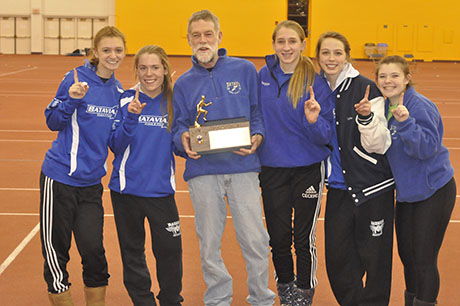
Both the boys and girls track teams from Batavia High School won Class C Section V championships in a meet at RIT last night.
Le Roy boys won the Class D title and the Le Roy girls came in second.
Batavia boys finished with 117.50, edging out Aquinas Institute, 74.50. The girls had 113 points and Wayland-Cohocton came in second with 110.
Le Roy boys beat UPrep Rochester 86-79, while the girls came in behind Marion, 71-60.
Individual event winners from Genesee County:
- Kimmy Lovett, Byron-Bergen, girls 600 meter run
- Batavia girls, 4x800 meter relay
- Kristyn Mott, Batavia, girls pole vault
- Julianna Lauricella, Le Roy, girls 600 meter run
- Becca Schwan, Le Roy, girls 1000 meter run
- Raelynn Moskal, Alexander, girls 1500 meter run
- Le Roy girls, 4x400 meter relay
- Le Roy girls, 4x800 meter relay
- Alex Egeli, Batavia, boys 55 meter dash
- Alex Egeli, Batavia, boys 55 meter hurdles
- Batavia boys, 4x200 meter relay
- Batavia boys, 4x400 meter relay
- Devon Koepp, Batavia, boys shot put
- Ryan McQuillen, Le Roy, boys 55 meter dash
- John Woordworth, Le Roy, boys 1000 meter run
- D.J. Ohlson, Alexander, boys 55 meter hurdles
- Le Roy boys, 4x800 meter relay
- D.J. Ohlson, Alexander, boys high jump
- Ryan McQuillen, Le Roy, boys long jump
- Ryan McQuillen, Le Roy, boys triple jump
Photos submitted by Nicholas Burk

Batavia couple were inseparable for 60 years, right to their final days
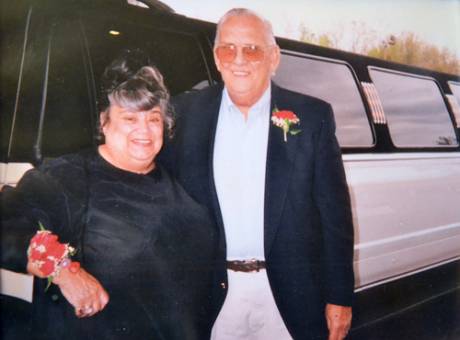
Batavia residents Ed and Floreen Hale were married for 60 years and for all those years, according to family members, they were inseparable.
A week ago, they spent their final hours together in the same room at UMMC. Mrs. Hale died Feb. 7. Mr. Hale passed the next day.
“He was a gentleman right up to the end, waiting for her to go first,” said the couple’s daughter Renee Hirsch.
For the full story, visit Orleans Hub.
Notre Dame Boys Basketball Team honored as #1 seed entering sectional play
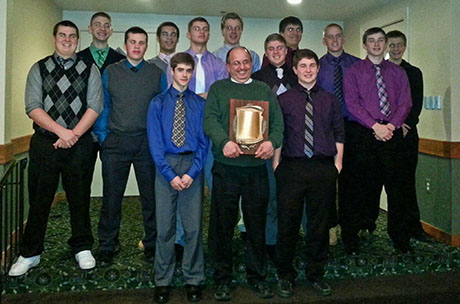
The Notre Dame Boys Basketball Team was honored last night in Rochester at the Section V banquet. The award was for finishing the season as the #1 seed in Class D1. The Fighting Irish open their sectional play at home Saturday. Game time is 7 p.m. and ND will play the winner of a round one match between Elba and Finney.
Photo submitted by Shelley Falitico.
Former Marines in Batavia open personal defense training business
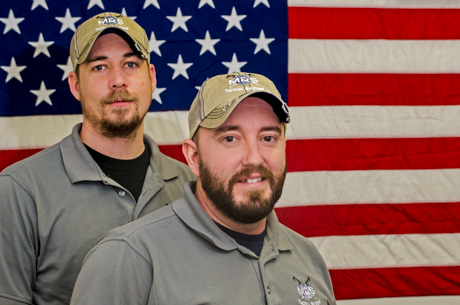
The way Jeff McIntire and Matt Smith see it, Gov. Andrew Cuomo gave their business idea a nice boost when he pushed through the SAFE Act.
Cuomo, with the stroke of a pen, created more reasons for people interested in self defense to buy guns.
And many of those people have never been properly trained on how to handle a weapon, how their particular weapon works and exactly what to do if confronted with a dangerous situation.
"The SAFT Act put a rush on gun stores," McIntire said. "A lot of people go to buy a weapon and you're in the store and you hear them say, 'I want to buy a shotgun.' 'Well, you ask, why do you want to buy a shotgun?' 'I don't know. I just want to buy a shot gun.' They ask all sorts of questions. That SAFE Act completely allowed us a reason to be in business because people need to know this."
McIntire, Smith and Dave Eick are combat veterans and experienced Marine Corps instructors. Together, they've opened MandS Tactical Solutions with an office in the Harvester Center.
They teach a variety subjects around personal protection and civilian weapons use, shotgun personal defense, home defense, pistol defense, rape prevention and improvised weapons defense.
Opening a civilian defense course business just seemed like a logical step for the former Marines, McIntire said.
"You sit back and think, what am I going to do with an infantry background in the civilian world? What am I going to do? Why wouldn't we do this? We get to go to the range every day and do something we love. We know this more intimately than anything else."
McIntire and Smith met their first year in the Marines and served much of their career together. They were both wounded by an IED in Iraq in 2007 and both received Purple Hearts.
They've also trained other Marines in combat techniques.
McIntire grew up in Batavia, as did Eick. Smith is from St. Louis.
What they teach civilians consists of proper weapon handling, safety and care, but they also teach combat mindset.
If you're going to own a gun for self-defense, you better be prepared to use it. Just holding it in the hopes an intruder might retreat could be more dangerous than not having a gun at all.
"If I can show it to a person who is breaking in, maybe I can show it to them and maybe they'll run away," said McIntire taking on the role of a new, first-time gun owner. "Well, what happens if they don't? 'Well, I don't know what to do.' That's where we come in."
The combat mindset is necessarily about how to pull the trigger. It's also about not pulling the trigger.
"If we teach you everything we need to teach you, you won't ever need to pull the trigger because hopefully you will deter the intruder," Smith said. "The intruder will be like 'maybe I need to leave. This person is serious.' "
If you don't learn that mindset and you do need to pull the trigger and you freeze up, Smith said, "you might not be around much longer."
"We train people so that hopefully they never have to pull trigger," Smith added. "With the training, if comes down to that, they will know exactly what to do."
The training, in fact, may help a person later with the law. Your best defense if you shot a person who is a threat to you is if you can explain what you did, how you did it, why you did it and your confidence that you had no other option.
"The law may say you're justified, but you might not want to take that shot," McIntire said. "We're not teaching anybody to shoot anybody. We're teaching you to be prepared. We're teaching you how to go through the steps until you reach the point where you feel your life is in danger. Hopefully it helps a person, if they ever get in that situation, where they can intelligently say, 'I pulled the trigger. I shot him because I had no other choice.' "
McIntire and Smith are not offering, per se, a set course list. They have a list of topics they cover, subjects they can teach, but they like to meet individually with their clients and make sure they understand their needs.
Instruction can be in a group environment or one-on-one, especially if a client needs or desires privacy.
"We ask, you want to do this? OK, what do you want to do with it?" Smith said. "They might want to take something out. They might want to put something in. We try to customize it rather than just what an overall person might want.
"We pride ourselves the fact that we're not a cookie-cutter organization," he added.
For more information, visit the MandS Tactical Web site.
Miniature scenes at HLOM capture the history and the reality of the Civil War


An Army field hospital during the Civil War must have been a horrid place to be. The stench of curdled blood. Limbs piled under the surgeon's table. The moans of the injured and dying. The acrid aura of death hanging in the air like a fog. The distant sounds of cannons turning more boys into fodder.
Hades holds more joy.
Warfare will always be a horror show, but it will never be like that again. The primitive conditions of a Civil War field hospital are just part of history now.
It's a history that can be found in museums, but not often quite in the way it's on display now at the Holland Land Office Museum.
Through April, visitors to HLOM can glimpse a time long ago in color and in 3-D, and in 1/32nd scale, when there was never enough morphine, scalpels were blunt and gangrene left a generation of young men crippled beyond repair.
In a display of dioramas and models created by local artist Dave Armitage, the Civil War comes to life in a way that mere photographs and historians' voluminous accounts can never capture.
We call Armitage an artist because like an artist, he creates, he imagines, he takes the formless and fills a void with a world that we all can share. He's more than just a model maker, though he might be too humble to call himself anything else.
The field hospital, part of a exhibit of dozens of models and dioramas at HLOM, all meticulously pieced together by Armitage, is such a work. It's creative and emotionally charged.
Armitage is originally from Williamsville but has lived in Batavia for a number of years. Since childhood, he's built more models than he can count. "Thousand and thousands," he said.
"People say, 'you've got too much time on your hands,' " Armitage said. "I say, 'no, I haven't got enough.' I've got (a) room in my house filled with unbuilt model kits that filled up two SUVs when I moved. Several thousand dollars worth of unbuilt kits. Some go back to the 1950s, the 1940s and some are made out of wood, not plastic. I figure someday, if I live long enough, I'll build them."
The only models that interest Armitage are those that depict something old, and old means before his lifetime, before the end of World War II.
"Anything after that is in my lifetime," Armitage said. "I mean, I saw it and I've been there. I'm interested in old things. When I was a little kid I was interested in old cars. I always used to draw pictures of old cars."
When he was a kid, his father's friends and relatives would come over to their house and the group would work on old cars. The boy was given model kits to work on -- the Revell Pioneer Series of the 1950s.
By the time Armitage was 17 he had worked enough and saved enough to buy his own Ford Model T, which he restored and still owns, along with three other vintage cars (a 1919 Model T Touring car, a 1925 Model T Depot Hack and a 1926 Star Station Wagon).
The 64-year-old Armitage is also a musician and Civil War reenactor, as is his wife, Donna. He's retired and he spends his time with this hobbies.
"I don't go out for sports. I never did," Armitage said. "I don't watch television very much. I spend all my time building models or playing music or working on old cars."
The Civil War isn't the only war that interests Armitage. He's built models and dioramas for battles scenes from the Crimean War, the American Revolution, the Russian Revolution, World War I and World War II.
"I don't like painting figures from the Napoleonic Era and back because they're too complex," Armitage said. "Their uniforms are too difficult with all the straps and buttons. The Civil War is bad enough."
And war isn't Armitage's only subject. There's old cars, of course, but Armitage also remains fascinated with the horror films of his youth - "Frankenstein" and "Dracula," and even "The Munsters."
In fact, Jeff Donahue, the director HLOM, is talking about displaying Armitage's monster collection around Halloween.
Donahue has been aware for some time that Armitage built models of history and had seen a couple, but never considered a display until Armitage approached him after one of his Civil War music performances at the museum.
"He asked me over to his house and I walked in and I was in shock," Donahue said.
What's on display at HLOM is only a portion of the Civil War collection.
"I had them stacked three or four high at home," Armitage said, "and Donna said, 'you're not building more stuff are you?' and I said, 'yeah.' 'Where you gonna put it?' 'I don't know.' "
The collection has rarely left his home. He's displayed some models at the train museum in Medina and he's taken a few to the Civil War reenactment camps, but they don't draw much attention there.
"I think most of the time people are more interested in watching the battles and the things going on outside," said the soft-spoken Armitage, whose gray mustache is as much a throwback to the 19th Century as some of the models he builds.
The Civil War collection at HLOM covers the panoply of the Battle Between the States. There are miniatures of historical figures from Robert E. Lee and Jefferson Davis to Ulysses S. Grant and Abe Lincoln; there are scenes depicting historic events; scenes depicting behind-the-lines life; and models of the machinery of war, from cannons to submarines.
"Dave has reproduced this to the finest minute detail," Donahue said. "It's shocking in a way, but of course war is shocking and the Civil War was a very horrible time. The man is a very gifted artist and this is artistry."
For many of the models, Armitage has typed up captions in the hopes that people will read and learn a little more about the Civil War.
"If they read half of what I typed up, they might learn something," said Armitage, a man of few words who gets right to the point on any question asked.
It's fascinating to see the old ships of the era, but what's interesting is the variety and number of ironclads and submarines on display.
We grow up learning about the Monitor and Merrimack, but have you ever seen the USS Alligator or the CSS Hunley?
Some of what Armitage builds comes from kits -- the ships and ironclads, for example, but what is often most fascinating and amazing are the scenes he depicts using a combination of kits and scratch-built pieces
The field hospital scene, for example, began with a model kit for a Union ambulance -- a wagon that could carry four wounded men and two medics.
Armitage didn't want to build just an ambulance. He wanted to put it in context.
A good portion of the scene springs from his own imagination and ingenuity, such as the tent, the scalpels and medicine bottles, the light by General Grant, or repurposed pieces, such as the surgeon that was originally a 1930s-era gangster, but Armitage shaved off his overcoat and put a blood-stained smock on him.
The black man sitting all bandaged up was created by Armitage from modeling clay.
On another model, the oars of a rowboat are shaped from soldering iron.
"You've got to think outside of the box," Armitage said. "You see something and think, 'I can make something out of that,' like I save the little brass rings from the ends of guitar strings and all kinds of junk."
Armitage said he has boxes and boxes of junk -- what model makers often call a boneyard -- waiting to be made into something.
When it came time to depict The Andrews Raid (the basis for the Disney movie, "The Great Locomotive Chase"), Armitage used toner from a copier cartridge to get the charred, burned out look on the blown-to-smithereens train station and littered the scene with repurposed former toy trains.
"I couldn't find any suitable Civil War soldiers in fatigues so I used Russian soldiers and shaved off their pockets," Armitage said.
Some of the scenes created by Armitage are inspired by photographs, such as the Matthew Brady picture of skulls and body parts being exhumed from the battlefield at Cold Harbor, Va.
"A lot of the soldiers pinned their names into their coats because they knew they weren't going to survive," Armitage said. These were the days before dog tags. When they dug them up, if they could identify the remains they notified somebody back home and if the family could afford it, they shipped the remains back home and buried him. If not, they reburied him there."
The scene might be shocking to some, but then war is shocking.
"As we've often said, history is not Hallmark," Donahue said. "History is not pretty. The Civil War was perhaps the ugliest times in our country's history.
"(The scene) brings a realization to people of what it was all about. What this country went through at that time. Families were literailly torn apart. The old saying brother fighting brother, well, happened. You didn't know if you would ever see your family members again or what kind of condition they would be in. The amputations, the horrific wounds of the war, due to the type of weaponry being used. Unfortunately, when a person was shot in the arm, many times it exploded the bone and there was nothing left to do but amputation. People died of shock from their injuries.
"It certainly brings home the cruelty of war. Very often people think, it's romanticized. They see the banners and the soldiers all dressed up and they think of maybe 'Gone with the Wind', but even later on in that movie, they showed the cruelty of war, how people were torn up, their lives were disrupted and never the same."
Armitage's work so masterfully captures a time and a place that is part of the fabric of our history that it's easy to get lost in the exhibit.
"I've had visitors come in, and you know, they normally spend five minutes or so to walk through," Donahue said. "With this, they come in and and you get busy working and you realize I haven't seen these people in a while and you go up and you look and they're in here an hour later, just examining every minute detail."
Armitage is grateful HLOM is providing a place for people to come and see his work.
"I'm glad to have stuff on display here because most of the time it just sits around my house and nobody sees it," Armitage said.




City fire testing iPad with apps to help manage emergency responses

Spock had his tri-corder, a device at his fingertips that could provide him with information quickly in any emergency situation.
City of Batavia firefighters now have an iPad and as the saying goes, "there's an app for that."
In this case, there's apps that can map their calls and tell firefighters where all the hydrants are in a neighborhood, and an app that tells them how the batteries are configured in hybrid cars, and an app to help them deal with hazmat situations.
Last week, Lt. Bob Fix installed a special iPad in Engine 11 as part of a pilot project to see if such a device can assist firefighters in emergency situation.
The iPad uses an app called Active911 that ties in with the county's emergency dispatch center (soon to be replaced by a new app tied into the new communications system). When City fire receives an alarm, all the details go to Active911 and the scene commander can have at his fingertips all of the information about which firefighters are responding (especially in a multiple alarm situation) and help him position trucks based on the location of hydrants.
The hybrid car app is useful in auto accidents, since hybrids have both areas that are reinforced and too hard to cut through and places pulsing with high voltage that a firefighter wouldn't want to cut. With the iPad, a commander can punch in make and model and get a copy of the schematics for the car.
The hazmat app, created by the Federal Government, lists 438 chemicals that are potentially hazardous. If a firefighter doesn't know the name of a chemical, he can punch in the characteristics and the app will help him identify the chemical. The app uses wind speed and direction to map an evacuation area and provides information on how to fight any related fires and how to treat any victims with possible exposure to the chemical.
Fix said if the trial goes well, iPads will be installed in the department's other emergency vehicles.



Gas station robber enters guilty plea in County Court
Justice has been swift for Edward Wood III.
When he robbed the Sunoco gas station on West Main Street on Jan. 21, police had him in custody three minutes after being dispatched to the scene.
Today, less than a month after the robbery, the 21-year-old Batavia resident who used an Airsoft gun in the commission of his crime, admitted his guilt before Judge Robert C. Noonan.
Wood entered a guilty plea to attempted robbery, 2nd, a slightly reduced charge from the original count of robbery in the second degree, menacing, 2nd, and criminal mischief, 4th. The plea also satisfies two pending, unrelated misdemeanor charges.
While the plea still exposes Wood up to a potential seven years in prison, the reduced charge -- since he has no prior felony conviction -- also leaves open the possibility of a probationary sentence.
Sentencing will be March 12.
He remains jailed on $25,000 cash bail or $50,000 bond.
Laurie Call, first player in Notre Dame history with 400 steals in basketball

We were remiss earlier this week in not posting about Laurie Call of Notre Dame reaching a significant basketball career milestone -- her 400th steal. She's the first player in Notre Dame history -- boys or girls -- to reach 400 steals. Pictured with Laurie are her parents Tim and Dawn.
Photo submitted by Tim Call.
Law and Order: Parolee accused of possessing needle
Michele L. Difalco, 25, of West Main Street, Batavia, is charged with possession of a hypodermic instrument. Batavia PD assisted NYS Parole at the residence of Difalco. Difalco was allegedly found in possession of a hypodermic instrument.
Dustin M. Fleming, 26, of Telephone Road, Le Roy, is charged with unlawful possession of marijuana. Fleming was arrested after Batavia PD officers responded to Denny's Restaurant to investigate a complaint of an intoxicated person at that location. Fleming was found allegedly in possession of a small amount of marijuana and a glass pipe.
John Thomas Harley, 35, of Rich Place, Lacawana, is charged with operating with a suspended registration and aggravated unlicensed operation, 2nd. Harley was arrested on a warrant upon his release from the Erie County Jail. Following arraignment in Darien Town Court, he was jailed on $500 bail or $1,000 bond.
Guns stolen from a shop in Alabama, suspects in dark colored pickup
Within the past hour, a gun shop on Route 77 in Alabama was burglarized and guns were stolen.
The suspect vehicle is a dark colored pickup truck, unknown direction of travel.
State Police are on scene.
UPDATE 10:43 p.m.: Orleans County dispatch has informed Genesee County dispatch of a possible related burglary in that jurisdiction. Communication equipment, such as that used by fire and police personnel, were taken. It occurred after the Alabama burglary. The Alabama suspect vehicle is described as an S-10 type of pickup truck, dark in color, with a loud exhaust.
UPDATE 11:45 p.m.: Seven double-barrel shotguns are missing, too.
Lost Dogs: Deacon and Mavis

Owner Dawn Wolcott said they ran off Monday night and haven't returned.
Wolcott lives in Attica. She isn't sure what direction they headed, but is hoping somebody in Genesee County might know their whereabouts.
They are rescues from Buffalo and Wolcott has had them about a year.
Deacon has a white and green collar and tags. Mavis has a red collar and tags.
Wolcott can be reached at (585) 297-3241.
Photos: Preschoolers get visit from Batavia fire
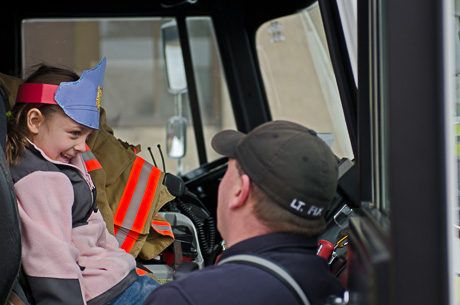
Four-year-old Aubrey was thrilled to have Lt. Bob Fix, Batavia FD, hoist her into the seat of Ladder 15 during a visit by the fire department to Imagination Station, the day care and preschool on Union Avenue.
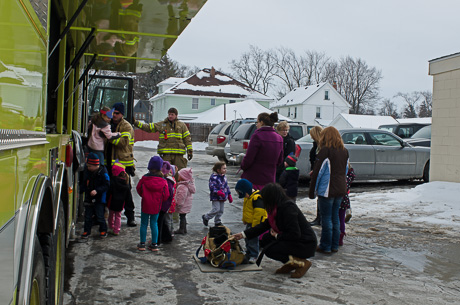


Knights give Cal-Mum a fright but let game slip away in closing seconds

Le Roy almost pulled off an upset against archrival Cal-Mum on Wednesday night.
But there's no almost in basketball. And there are no moral victories.
"They played good," said Rick Rapone, Le Roy's first-year head coach. "But you've got to play 32 minutes. You can't play 31 minutes and 50 seconds. You've got to play it the whole way out."
With the score knotted at 57, the Red Raiders took possession of the ball with less than 20 seconds left on the game clock.
It only took a couple of passes to get the ball to a wide open Chris Wilson just beyond the arch. His three-point swoosh gave Cal-Mum the lead with only 4.8 seconds left.
Three points is a big deficit to erase with only a few ticks to go and the Oatkan Knights were forced to settle -- no matter how well the game was played for 31 minutes and 50 seconds -- with a 60-57 loss.
"I told the kids I'll feel good when we finish one of these games off," Rapone said. "We've got to play 32 minutes."
Le Roy finishes the regular season with a 7-11 record and will open sectional play Feb. 18 against Bath-Haverling (8-10).
An upset over the 17-1 Red Raiders would have given Rapone's program a nice boost, but he still feels good about his team heading into the championship rounds.
The Oatkan Knights under Rapone play a fast-paced offense and pressure defense that should give a lot of teams fits.
"You really don't want to play us," Rapone said.
"Our program is going in the right direction," Rapone said. "We have gotten better every single week since I started and we're hoping now this catapults us into the tournament."
The Knights certainly had Cal-Mum's Dan Dickens pulling at his collar in the second quarter and the Raider's fans on the visitors' side of the bleachers grumbling, "we're better than this."
With the Raiders down by a dozen points in the second period, Dickens called a time out, sat his starters down and gave them a good tongue lashing.
A Raider's fan told another, "they deserve it."
But it's hard to stop a hot hand and Knights certainly had that going for them in the first half, dropping six three-point shots (compared to none in the second half).
As the second quarter wound down, Cal-Mum cut Le Roy's lead to two points and the second half would be a battle with neither team gaining a clear advantage until those fateful closing seconds.
"We held them to 60 points," Rapone said. "I don't think they've been held to 60 points very many times this season."
Zack Moore led the Knights with 20 points, including two threes, and going four of six from the foul line. Nick Egling had 10 points, including a pair of threes in the first quarter. Mike McCullen was four of five from the foul line and finished with six points. Ethan Witkowski and Kody Lamkin had seven points each.
Kurtis Haut and Will Van Auken had 18 points each for Cal-Mum and Chris Wilson scored 13.
For Le Roy, Lamkin had eight rebounds and Moore had seven. Steve Cappotelli and Moore each had three assists.
For Cal-Mum, Van Auken was a monster on the boards with 13 rebounds. He also blocked four shots.





To purchase prints, click here.
Baskin Livestock named Conservation Farm of the Year
Press release:
The Genesee County Soil and Water Conservation District Board of Directors has announced the selection of Baskin Livestock as the 2013 Genesee County Conservation Farm of the Year. Baskin Livestock will be the honored guests of the District at the Celebrate Agriculture Dinner on March 22th at the Alexander Firemen’s Recreation Hall. They will be formally presented with their award at that time.
Baskin Livestock is owned and operated by Bill Baskin and Susan Blackburn. Bill purchased the former James Hume Jr. Dairy Farm from Chester Ptak in 1992. Since that time, Bill and Susan have acquired several neighboring farms (John Gardner, 1996; James Hume – remainder, 2001; Kruszelnicki, 2001; Don Norton, 2005; Woodhouse, 2007; Ethel Cook, 2009) and now own a total of 1,748.66 acres in the towns of Alexander, Bethany and Batavia. Of that total 1,157 acres is cropland. Most of the cropland acreage is fenced for pasture. Little Tonawanda Creek runs through the farm. With only a few exceptions, livestock is fenced out of the stream channels. Baskin Livestock became a District Cooperator in January of 1993. They started working on a plan for grazing in 1995. A grazing plan was written by Art Hanson of Western New York Crop Management (WNYCMA) in April 2001. Baskin Livestock is a medium Concentrated Animal Feeding Operation (CAFO) and has a Comprehensive Nutrient Management Plan (CNMP) completed by WNYCMA in July of 2002. Baskin Livestock is active in the Agricultural Environmental Management Program (AEM) .
They raise dairy replacement heifers, beef, and quarter horses. Recent conservation practices installed with district assistance include heavy use area protection (bedded pack), waste transfer system, roof runoff structure, compost facility, and waste storage facilities. Baskin Livestock has one of the most extensive grazing (pasture) systems in the County.
Insource receives urgent care designation
Press release:
Insource Urgent Care Center of Batavia Receives Certified Urgent Care Designation from the Urgent Care Association of America
Insource Urgent care Center of Batavia, located in the Batavia City Centre, has received the Certified Urgent Care designation which distinguishes it as a true urgent care center. The clinic provides patients with walk-in, extended-hour medical attention with licensed providers for a large scope of medical conditions and has met all of the Urgent Care Association of America’s established criteria.
The health care environment is changing and it is becoming more and more important for patients to understand their treatment options.
Urgent care is a convenient and viable option for medical conditions that cannot wait for a scheduled appointment with a primary care physician. Insource Urgent Care accepts unscheduled, walk-in patients during all hours of operation.
When a medical condition cannot be handled by a patient’s regular doctor – such as unexpected cuts, burns, sprains or fractures that do not require a visit to the emergency department, Insource Urgent Care is equipped with x-ray, laboratory services and a licensed provider is always available to perform minor procedures like casting and suturing.
Urgent care fills the gap between primary care and hospital emergency rooms, offering increased convenience and cost savings.
With its certification, Insource Urgent Care and the Urgent Care Association of America demonstrate their commitment toward providing patients with access to appropriate levels of care.
Possible vehicle fire reported on Vine Street
A possible vehicle fire is reported on Vine Street, across from John Kennedy School.
Batavia fire is responding.
UPDATE 9:40 p.m.: No fire. Smoke from oil leaking on a manifold.
Dog found malnourished showing signs of recovery, now in foster care

Nina Kelso certainly has her supporters -- friends and family members who have argued passionately on Facebook and on The Batavian that those who judge her and heap insults upon her and even threaten her don't know the full story.
She would never abuse an animal and her dog was ill not from mistreatment, they say, but because he unintentionally ate something toxic.
Darren Dewitt:
Don't judge this one too soon. I've known Nina for years and something is off with this whole deal. My understanding is that the dog was dying and instead of having the vet put it down she let it live out its days at home with the family. The court has the final word.
Lynda Kelso:
Can't help it when a DOG does what DOGS do and gets into something and it makes them sick. ... He got sick and was vomiting. How do u loose weight when u get sick? He was weak from what he ate. They were trying to get food in there right down to baby formula.
Nina Kelso's case began at 6:08 p.m., Feb. 4, when Sgt. Chris Camp and Officer Jamie Givens responded to a report on Hutchins Street of a malnourished dog.
When they arrived they spotted a canine inside that, according to the officers, was emaciated and couldn't stand on its own.
Dr. Fran Woodworth of State Street Animal Hospital was contacted to assist with the health care of the animal.
Woodworth said she arrived at the aninmal hospital around 7:30 and found a dog that was severally malnourished.
"He was emaciated and mentally he was dull and disoriented," Woodworth said. "I don't know how much of that was starvation or, the officers told me that his owner said he had gotten into potentially toxic substances, cigarette butts and incense oil or something along those lines, and that was why he was in shape in that he was in and had lost all that weight in just a couple of days. I don't know if he had gotten into some toxic substances, but he was definitely mentally not normal. He was just very depressed."
The dog had an intestinal infection, pressure-point sores and was blind.
Animal Control Officer James Sheflin began his investigation into the case the morning after the dog was brought to State Street. He took pictures and examined the dog and consulted with the District Attorney's Office on possible appropriate charges against Kelso (she was charged with torturing or injuring an animal, failure to provide sustenance, and owning/harboring an unlicensed dog).
"Honestly, he's the worst shape I've ever seen," Sheflin said. "The sores were over all his entire body. His feet were swollen two or three times what they should have been. His nails were overgrown. He literally didn't have enough strength to stand up. All he could do was lay down."
State Street staff monitored the dog's progress, unsure during those first 12 hours or so if the dog was going to make it.
But after 12 hours, the dog showed enough progress to warrant continued treatment.
Soon, he gained enough strength to stand up and he showed an interest again in eating.
The dog was brought in on a Tuesday and by Saturday it was in good enough health to be transferred to a foster family through Volunteers for Animals.
It's impossible to tell for sure, Woodsworth said, whether the dog ate anything toxic.
"Toxins are typically very short-lived," Woodsworth said. "They do their damage and then there is no sign of them in any blood test. They are gone. There was nothing in the blood work that was tagged as a sign of a toxin."
There's no indication the dog was brought to a vet for treatment prior to Camp and Givens picking them up, Woodworth said.
"He was overloaded with intestinal worms," Woodworth said. "There were pressure sores on all contact points, particularly his elbows and hind legs from being recumbent for so long. He hadn't eaten in weeks and was weak. That kind of emaciation doesn't just happen overnight.
"As far as I know," Woodworth added, "the owner never sought out veterinary help. What the dog needed was better nutritional care and parasite control and better health maintenance."
Woodworth isn't sure why the dog is blind or if the blindness will last. It's a problem in the dog's brain, not with the dog's eyes, she said.
That could be caused by a toxin, she said.
His mental state, depression, could also be the result of a "toxic insult," Woodworth said.
If the dog did ingest something toxic, veterinary treatment sooner would have been advised, she said.
"In fairness to her, the problems that I saw in the dog were primarily starvation and being recumbent too long," Woodworth said. "I didn't find any injuries inflicted by being kicked or being abused violently in that manner."
Woodworth is hopeful about the dog's improving health even if the prognosis isn't yet settled. The dog is in a good place now and that can only help him recover.
"It's too early to say if he will recover his sight," Woodworth said. "He retained his blindness after getting back on his feet, but he's acting normal otherwise. It was a joyful thing for us to see him on his feet and be interested in food by the next morning. He became rather attached to one of our technicians and began begging her for treats. He really showed some dramatic improvement in a short amount of time."
The Batavian tried to contact Nina Kelso through Facebook earlier today so she could tell her side of the story and have not received a response.
UPDATE: Nina Kelso contacted me about an hour after this story was published and said she prefers not to comment while her legal case is pending.
PHOTO: Batavia PD.
Pagination
- First page
- Previous page
- …
- 771
- 772
- 773
- 774
- 775
- …
- Next page
- Last page
